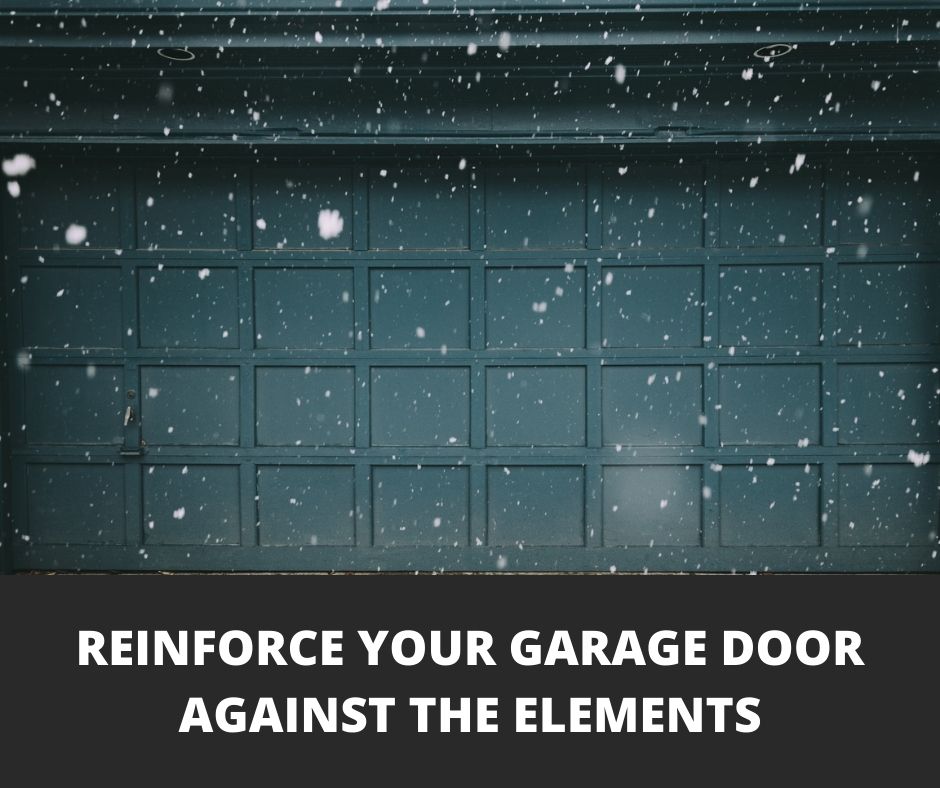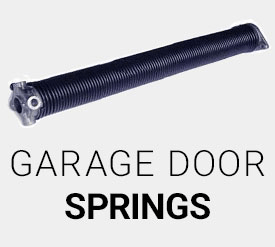When the weather turns bad and we look to protect our home, our garage door is often neglected even though it is a major vulnerability. We’ve all seen the destruction a storm can do. The wind, rain, and hail that come with it can be devastating to homes and other structures in its path. But what about our garage doors?
Garage doors are large expansive surfaces of metal or wood that are often built very light so that they can be raised and lowered easily. They are also only supported on either side of the entrance, not at the top or bottom. This makes them a major weak spot and prone to hurricane or storm damage.
If you reinforce your garage door, it is an affordable way to increase its resilience and life span.
Why Garage Doors are a Problem in Storm Season
Once your door has been laid open to the elements, anything you have stored in the garage will be exposed to rain and wind. If your house is connected to the garage, the issue can be compounded with a knock-on effect that can cause significant structural damage to your home.
The Federal Alliance for Safe Homes (FLASH) says that 80% of hurricane damage in residential areas starts with the wind entering through the garage doors.
When a hurricane-force storm hits, if you don't have adequate garage door reinforcement, it's likely to be a part of your home that takes the most damage. If the garage door installed is not strong enough, high winds can push it inward. This results in pressure building up inside your garage, which can do more than just knock things around: It can cause structural damage by blowing out windows and doors, knocking down walls if they're weak enough. In some cases, it can even blow out the roof.
Water and Flood Damage
Damage from wind during a storm is just one part of the equation. Water and flood damage can also cause devastation when a storm hits. Regardless if an emergency is predicted – flooding can happen unexpectedly with little warning. The best way to protect yourself against water damage is to always prepare for any type of weather, even when there's no threat of rain, snow, or high winds.
If water gets into your garage and breaches the foundation of your house, it can lead to reduced structural integrity. So it's not just your garage that is at risk of damage. According to the Federal Emergency Management Agency (FEMA), it is estimated that $25,000 of property damage can be caused by just one inch of floodwater.
As well as ensuring that your garage door is adequately reinforced to withstand hurricanes or other extreme weather, here are some other measures you can put in place.
Make sure you have an adequate drainage system for rainwater or snow runoff, which should include gutters and downspouts. In addition, they should be regularly cleaned to prevent debris from clogging them up.
Ensure your garage door seals tightly against the ground so that water doesn't seep in underneath it, check the weatherproofing regularly, and if it looks worn or cracked, ensure you replace it.
Keep an eye out for any leaks or cracks in the foundation, which may indicate that you need some repairs.
As a last-minute fix, if you know that a storm is about to hit soon, you can use sandbags to divert the water away from your garage door. The rainwater will hopefully be redirected to roadside gutters and storm drains.
Reinforce Your Existing Garage Door
Many new garage doors are now engineered to deal with wind pressure. If you own an older garage door, it will probably mean you'll need to retrofit the door to reinforce it. To find out if your garage door meets wind speed rating and pressure rating regulations, look for a sticker on your door.
The ideal solution would be to replace an older, weaker door with a code-approved garage door as soon as possible. If you do have an existing garage door that isn't wind-speed rated, you'll need to reinforce it using other retrofit solutions until it comes time for you to replace it.
Opener Reinforcement Brackets
Garage door reinforcement brackets are a simple way to improve the strength and durability of your garage door. They are designed to help reinforce your garage door opener’s lifting, lowering, and opening mechanisms. Garage doors are often exposed to heavy use and constant wear, which can cause them to weaken over time.
Opener reinforcement brackets are designed to replace the smaller original brackets that come with standard garage door openers to provide better stress relief. The brackets are installed to the top of your garage door on the center stile. They serve to evenly distribute the force of the opener that pulls the door, so it doesn't crack or stress. There are times, for instance, in the cold months where the bottom of your garage door can freeze to the floor. This can result in the center stile being ripped from the garage door panel due to the excessive tension it is under if not adequately reinforced.
Opener reinforcement brackets are available in a wide range of colors, sizes, and styles and can be installed on most types of garage doors. They are a cost-effective way to protect your door and are easy to fit, with no complicated installation procedures. You can choose from narrow adjustable brackets designed for most residential homes or wide adjustable opener reinforcement brackets that are a heavy-duty solution for commercial or heavy wood doors.
How to Install Opener Reinforcement Brackets
- Decide on the type of bracket you'll need and purchase it online or from your local hardware store
- Lock the garage door in the closed position and unplug the opener
- Remove the old bracket
- Install the new opener reinforcement bracket, following all of the manufacturer's instructions for installation
- Test your garage door to make sure that it opens and closes properly
Garage Door Reinforcement Struts
Now that you have installed your reinforcement opener bracket, you should consider installing horizontal garage struts.
Horizontal garage door struts are long metal bars that are installed on the interior of your garage door. A garage door strut helps support the door’s weight when open and reinforce it when bad weather hits. Without garage struts, the weight of your door can cause bending or bowing if left open for too long. This can result in damaged panels and even a broken door opener. You'll commonly find them in lengths of 9 to 18 feet, but longer ones are available.
Many garage doors come with a strut as standard that runs across the top panel section, but in some cases, for instance, in areas that experience inclement weather, you might want to install more struts. Other factors include the thickness and materials of your door. A garage door that isn't insulated and is lightweight will tend to bow more than one that is polyurethane foam insulated but the same thickness.
It is suggested to install three reinforcement struts on a 7-8 foot wide double garage door.
Before you purchase and install a new garage strut, bear in mind that they will add to the door’s weight once installed. This means that the door will need to be recalibrated to compensate for the weight change, or in some instances, you might need new heavy-duty torsion springs.
When the struts are joined, they can look like a ladder for your garage door. But it is important for your safety that you never climb on them to reach for items stored above the door. If you have children, who might be tempted to use the garage door struts as a climbing frame, they should be warned that it could cause serious injury and be strongly discouraged from doing so.
Garage Door Storm Braces
A storm brace for your garage door stabilizes the door and helps to prevent damage. Storm braces are strong aluminum or steel metal pieces that attach to the top of your garage doors. These braces help keep your garage door in place during high winds, storms, snowstorms, hurricanes, etc.
This bracing device attaches to the wall of your garage or, in some cases, the ceiling. It has two arms that extend from one end, and when an impact happens on the other end, it will prevent all of the force from being concentrated at one point.
Another benefit of using a storm brace is that it will add structural support to your existing garage door hardware, which can extend the life expectancy of both your hardware and your door itself.
Storm braces are easy to install, but they must be installed correctly, or else they won't be very effective at protecting your garage door from damage. You can buy ready-to-install garage door storm brace kits that cost around $500. These garage door storm brace kits are reasonably easy to install if you have some basic DIY skills. The other option is to build your own with wood.
How to Install DIY Garage Door Storm Braces
Installed correctly, storm braces will not only provide your garage door with extra support but should limit movement in either direction as well as help to keep it from being bent or pushed out of its tracks by heavy winds.
You'll need five to six pieces of 2x4 treated lumber, steel brackets, and concrete anchors.
Then follow these steps:
- First, you want to make sure that your automatic door has been unplugged for safety.
- Then, find where the hinge points line up along the garage door panels; this is where the 2x4 braces will be vertically aligned.
- A two-car garage will typically require two supports.
- Install the first piece of 2x4; this will provide a sturdy base for the brace and should be installed at the very bottom of your garage door. And you want to extend it just beyond where your hinges are on either side.
- To decide where you'll anchor the floor brace, place a 2x4 against the hinges and make an X on the ground. With concrete screws, secure the 2x4 directly to the floor.
- The next step is to locate a point to affix the brace support mount; this will be directly above the hinges and between the top of your garage door and the torsion spring.
- The support frame mount will comprise 2x4 blocks of wood cut to fit on top of the garage door. These blocks are screwed together in the shape of an L extending past the top edge. Attach the vertical braces to the L frame mount using the door hinges as a guide. Make sure that you line it up correctly.
- The vertical braces will be two pieces of 2x4 cut to length and secured together with screws creating a T-shape. The height of the first piece of 2x4 board will be from the garage floor to the top of your door—the second 2x4 from the floor brace to the mounting bracket.
- The T shape (the shorter 2x4) rests directly on the floor, fitting flat against the garage door. The other 2x4 rests on top of the floor brace and is attached to the top mounting bracket.
- For the second vertical brace, follow the same process.
Wind-Rated Garage Doors
In some parts of Florida that are particularly hurricane and storm-prone, it is a requirement that garage doors have a rating to withstand winds of up to 150 mph. There are even hurricane-rated doors that are so heavy duty they are resistant to winds of up to 200 mph so that they can handle a category five hurricane!
However, outside of Florida before 2006, wind-rated garage doors were not a requirement.
These days, if you live in an area that is prevalent to storms, you will probably be required by your local building code authority to have a garage door installed on your property that is approved to meet a specific wind rating. Typically the further inland the county you live, the less stringent the requirements. States that have special wind-rating requirements include Florida, California, Kansas, Nevada, Missouri, and Utah.
How are Wind-Rated Garage Doors Different From Standard Doors?
Wind-rated garage doors are designed to withstand high winds and are built with a robust steel frame and sturdier panels. They also have a heavier, thicker gauge garage door track and include post or built-in reinforcement. A third party tests wind-rated garage doors for durability and resistance to wind load. The test determines the amount of pressure that can be exerted on the door and how long it takes for the door to fail under those conditions.
Can Insulation Help Reinforce Your Garage Door?
The benefits of garage door insulation are many and varied. For example, insulated doors keep your house warmer in winter and cooler in summer by blocking out heat or cold from entering through the walls. This means fewer energy costs. However, while there is no doubt an insulated garage door has many benefits, does it make it more damage resistant?
Typically the more layers of insulation, the more durable and stable your garage door will be due to the increased support of the panels and added weight.
The insulation commonly used for garage doors is either polyurethane or polystyrene (styrofoam). Most experts agree that of the two, the superior material is polyurethane. Polyurethane is sprayed into the garage door panels, which improves rigidity.
Further Tips: Do's and Don'ts
It might seem obvious but make sure your garage door is closed before a hurricane or heavy storm hits. With many households using the garage as a second front door, it can often be neglected and left open, don't let this be you!
If you have completed a retrofit on your garage door to add reinforcement, it can get out of balance. To check if it is balanced, disconnect the opener, lower your door halfway, and then let go. If it shows movement and goes down or up, then it is not balanced. This means that the springs should be adjusted. Garage door spring adjustment can be dangerous if you are unsure of the correct procedure for your and your family's safety. It is best to seek out professional garage door services.
When installing products to reinforce your garage, it's really important that you follow the specifications recommended by the manufacturer. Special care must be taken when installing your product to avoid voiding the warranty or the potential of causing harm to people or property.
In Summary
Making sure your garage door is reinforced should be high up on your list of priorities. While some areas are more prone to hurricane-force winds than others, extreme weather conditions and high winds can hit even the calmest of US states. Whether you install a brand new garage door tested for wind resistance or retrofit your existing door using reinforcement brackets and garage struts, it pays to be prepared.





